Wu Gang
 Wu Gang (|s=|p=Wú Gāng}}), formerly romanized as Wu Kang and also known as Wu Zhi in some sources, is a figure in traditional Chinese folklore and religion. He is known for endlessly cutting down a self-healing osmanthus tree on the Moon,}}), which originally referred to both the sweet osmanthus (now }}, "''guì'' flower"), a species of olive, and the cassia (now }}, "meat ''guì''"). Because of the latter's greater importance in modern international trade, it is often encountered in English translations although the sweet-smelling osmanthus is the one meant. See, for instance, Wolfram, who consistently translates ''guì'' (}}) as "cassia" while in fact describing and giving the scientific name for sweet osmanthus.
Wu Gang (|s=|p=Wú Gāng}}), formerly romanized as Wu Kang and also known as Wu Zhi in some sources, is a figure in traditional Chinese folklore and religion. He is known for endlessly cutting down a self-healing osmanthus tree on the Moon,}}), which originally referred to both the sweet osmanthus (now }}, "''guì'' flower"), a species of olive, and the cassia (now }}, "meat ''guì''"). Because of the latter's greater importance in modern international trade, it is often encountered in English translations although the sweet-smelling osmanthus is the one meant. See, for instance, Wolfram, who consistently translates ''guì'' (}}) as "cassia" while in fact describing and giving the scientific name for sweet osmanthus.In Chinese, meanwhile, the ''chengyu'' "pluck osmanthus in the Toad Palace" (}}, ''chángōng-zhéguì'') associating the lunar tree with passing the imperial examinations eventually led to the association of the tree with the true laurel, which bears similar associations in European cultures from its use in Greece and Rome. It is now known in Chinese as the ''yuèguì'' (}}) or "Moon ''guì''" and connected with the earlier myths.}} a divine punishment which has led to his description as the Chinese Sisyphus. In modern Chinese, the ''chengyu'' "Wu Gang chopping the tree" (}}; ''wúgāng-fáguì'') is used to describe any endless toil. The specific reason for his situation has varied in the sources, but Wu Gang's story dates back to at least the Tang dynasty. Provided by Wikipedia
-
1by Jing, Wei, Gang, Wu, Hong-bing, Deng, Jing-zhu, ZhaoGet access
Published in Journal of Forestry Research (2004)
Get access
Get access
Get access
Article in Journal/Newspaper -
2by Jiangong Wei, Tingting Wu, Xiuli Feng, Jinqiang Liang, Wenjing Li, Rui Xie, Gang WuGet access
Published in Geofluids (2021)
Get access
Article in Journal/Newspaper -
3
-
4by Yapeng Cao, Guoyu Li, Gang Wu, Dun Chen, Kai Gao, Liyun Tang, Hailiang Jia, Fuqiang CheGet access
Published in Water (2021)
Get access
Article in Journal/Newspaper -
5
-
6by Qingsong Du, Guoyu Li, Dun Chen, Yu Zhou, Shunshun Qi, Gang Wu, Mingtang Chai, Liyun Tang, Hailiang Jia, Wanlin PengGet access
Published in Frontiers in Earth Science (2021)
Get access
Article in Journal/Newspaper -
7by Shunshun Qi, Guoyu Li, Dun Chen, Fujun Niu, Zhizhong Sun, Gang Wu, Qingsong Du, Mingtang Chai, Yapeng Cao, Jianwei YueGet access
Published in Remote Sensing (2023)
Get access
Article in Journal/Newspaper -
8by Shunshun Qi, Guoyu Li, Dun Chen, Fujun Niu, Zhizhong Sun, Gang Wu, Qingsong Du, Mingtang Chai, Yapeng Cao, Jianwei YueGet access
Published in Remote Sensing (2023)
Text -
9by De-Hu Chen, Rui-Qi Lu, Xiao-Chun Ni, Ju-Gang Wu, Shou-Lian Wang, Bo-Jian Jiang, Ji-Wei YuGet access
Published in Asian Pacific Journal of Tropical Biomedicine (2015)
Get access
Article in Journal/Newspaper -
10by Mingtang Chai, Guoyu Li, Wei Ma, Yapeng Cao, Gang Wu, Yanhu Mu, Dun Chen, Jun Zhang, Zhiwei Zhou, Yu Zhou, Qingsong DuGet access
Published in Remote Sensing (2020)
Get access
Article in Journal/Newspaper -
11by Gang Wu, Guoyu Li, Yapeng Cao, Dun Chen, Shunshun Qi, Fei Wang, Kai Gao, Qingsong Du, Xinbin Wang, Hongyuan Jing, Zhenrong ZhangGet access
Published in Remote Sensing (2023)
Get access
Article in Journal/Newspaper -
12by Qingsong Du, Dun Chen, Guoyu Li, Yapeng Cao, Yu Zhou, Mingtang Chai, Fei Wang, Shunshun Qi, Gang Wu, Kai Gao, Chunqing LiGet access
Published in Remote Sensing (2023)
Text -
13
-
14by Gang Wu, Guoyu Li, Yapeng Cao, Dun Chen, Shunshun Qi, Fei Wang, Kai Gao, Qingsong Du, Xinbin Wang, Hongyuan Jing, Zhenrong ZhangGet access
Published in Remote Sensing (2023)
Text -
15by Qingsong Du, Dun Chen, Guoyu Li, Yapeng Cao, Yu Zhou, Mingtang Chai, Fei Wang, Shunshun Qi, Gang Wu, Kai Gao, Chunqing LiGet access
Published in Remote Sensing (2023)
Get access
Article in Journal/Newspaper -
16